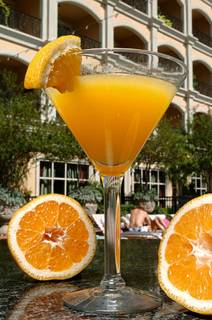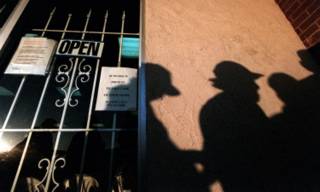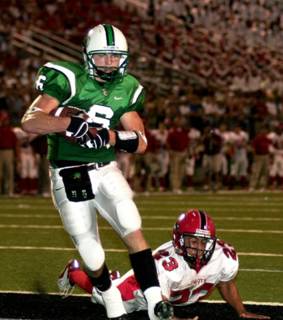Throughout this entry, I refer to potential "clients." It's meant to imply both freelance clients and staff employers. Substitute as necessary to reflect your personal goals.What are portfolios?A portfolio is a set of select images chosen to highlight a PJ's technical and aesthetic abilities. Everyone has different opinions regarding portfolios. Since each photographer and potential client is different, there's no one-size-fits-all answer to preparing a portfolio. However, there are some general guidelines PJs can use to favorably present their portfolios.
PJs need to consider which clients they want as well as the needs of these potential clients. Then, PJs must deliver appropriate images. All images must be compelling examples of the PJs' abilities to meet clients' needs.
Additionally, image presentation is important. The presentation should be professional and persuasive. Portfolios – and subcategories – must start and finish with the strongest images to leave a positive lasting impression with the viewer.
When the client has already seen thousands of images, the PJ wants the clients to close their eyes and remember her/his images. There is only one chance at this lasting impression. Likewise, each weak image has an equal chance of destroying the overall opinion of the editor.
Who are the clients?Because PJs are visual chameleons, clients can vary widely. Typical clients are newspapers, magazines, book publishers, record companies, trade publications, travel markets, galleries, and other business clients.
These markets are interested in the PJ's work as documents of reality. They all rely heavily on striking portraiture as well. In all of these markets, the PJ is specifically hired to make story-telling images.
Although advertising, greeting card, catalog, stock companies and design firms use photographs, those markets are considered
commercial and require a different code of ethics and business structure. They're not forbidden, but they're less cooperative to PJ goals and could cause conflicts of interests.
What clients do PJs want?Flexible, frequent and well-financed clients are best for PJs. Clients who give PJs flexibility of time, artistic design and even subject matter are great. However, it's important for the PJ to keep working behind the camera. The clients who give frequent assignments are preferred. It's also critical to make a living with competitive fees. The client who can provide all three is best for professional PJs.
Most PJs prefer to shoot a wide range of subjects. Although other photographers may specialize in a niche, PJs tend to prefer the challenge of changing gears from assignment to assignment. Clients should be chosen wisely to ensure the PJ gets a good mix of subjects to face intellectual challenges as well as expand upon the PJ's technical base.
Meanwhile, a series of one-time clients makes the PJ work harder to get assignments rather than make images. Many PJs are work driven (rather than business driven). Therefore clients who use many images and make multiple assignments have an advantage over other clients. It becomes a symbiotic relationship where the client needs many images and the PJ needs multiple assignments so both can continue to meet their goals.
Although this entry isn't directly about income, PJs don't benefit from flexible, frequent assignments if PJs lose money at the end. Although there are many worthy causes which offer desirable work for PJs, remember the rent is due on the same day every month and each equipment use is one step closer to a repair. Pursue clients who understand this.
Know yourselfPJs know what they like and hate to shoot. Different PJs can't stand to shoot sports, entertainment, breaking news, portraits, photo essays, food, fete sets, mug shots or any number of subjects.
The PJ must address these dislikes or be doomed to unhappiness (and potentially poverty). PJs do their best work on subjects to which they hold a passion. This inevitably leads to more assignments with similar subjects. It creates a positive, upward spiral for the PJ and the client.
The opposite holds true as well.
Know the clientResearch is the first step in direct portfolio presentations. Know the chosen market and specific outlets within the market. Understand exactly what images the clients use and why they use those images.
If the PJ were hiring a PJ, what would s/he expect and demand from an applicant. Once this step has been taken, it can be reversed and the PJ should include or exclude portfolio images which don't fit this ideal.
A farm and ranch magazine has little use for images from a Parisian fashion show. It wastes everyone's time to include wrong images in a direct portfolio presentation.
Ask questions about the images chosen for the publication. Are these stock images? Are these handouts from tourism bureaus? Was it staff produced or freelance? Who was the PJ? How much does this particular PJ normally charge? The list of questions can go onward. A simple online search for the same images elsewhere may answer many questions.
The important point is to understand how the client finally decided which images best suits the publication's style or "brand." It's often disappointing to find the upscale magazine's style is actually "cheap" (as in all handout photos).
Online portfoliosAn online portfolio is typically a generic portfolio. It's constructed to interest the widest possible set of image buyers and quickly steer them toward appropriate images. PJs want to show their abilities to focus, properly expose for the desired effect, gain access, work with subjects (portraits), use light, make good compositions, handle fast action and handle difficult assignments. Basically it shows everything PJs know about photography in 10 to 20 frames.
As PJs build libraries of premium images, they may choose to separate images by category. This steers potential clients toward images to which they'll relate. Ten frames per category is a good goal for divided online portfolios. Again, remember not to pad categories with inferior examples. If a PJ only has three great sports images, then only include those three images. More great images can be made in time. Be patient and don't lose potential clients.
An online portfolio is a point of reference. PJs refer clients to Web sites to see examples. The online portfolio by itself seldom gets a job for a PJ. It's simply an efficient way to present a PJ's portfolio to multiple clients simultaneously. Anyone who expects otherwise is heading toward disappointment.
If a PJ doesn't know how or doesn't have the time to create an online portfolio,
Fayrouz and other Web designers are always ready to help for a fee.
Direct portfoliosDirect portfolios typically take the form of 20 slides in a protective sleeve or a 20 image CD. It's mailed to a specific client for a specific job. As noted above, it must be researched and tailored for the client.
This approach is most likely to result in work. It places the portfolio directly into the hands of the person who makes decisions.
Each direct portfolio is accompanied with a cover letter and a Self-Addressed Stamped Envelope (SASE). The SASE is critical. It must have proper postage and be large enough to get the portfolio returned safely. Some PJs also choose to include a resume, client list and/or stock list (depending on client).
When submitting CD portfolios, it's most logical to ask the editor to retain the CD on file for future assignments and use the SASE for a reply or guidelines. Print © and your name along with a Web site address on the CD. Let the editor know additional images are available for review on the Web. This approach allows PJs to update Web site images and contact information as better images are acquired or contact numbers change.
SlidesA slide portfolio is more likely to be reviewed. The editor opens the envelope and can immediately hold it to a light and evaluate its worth. If it's good, s/he may put it on a
light box
or take it to a light table for a detailed examination.
Never send original slides. Instead, send duplicate slides (dupes). Always mark the slides with a © symbol and the PJ's full name and Web site and/or e-mail address. Use premium foil-backed slide labels to ensure they remain attached to the slide mount.
Slide portfolios require a
cutline sheet corresponding to the images by number or some other logical means. Don't assume the images will remain in the sleeve in the correct order. They can drop out in the mail or be rearranged by anyone who handles them.
Slide portfolios tend to be much more expensive than CD portfolios. Consequently, PJs are more likely to request a review and return of the portfolio. This is fine for internships and staff applications. However, the approach is counter-productive for freelance work unless the PJ includes a leave-behind brochure, calendar or other desk gadget to remind the editor about the PJ's work and availability. Of course leave-behind products add expenses to the PJ's marketing costs, but the cost may pay off with a future gig.
CDsA CD portfolio requires the reviewer to insert an unknown disk into a critical use computer. This requires the editor to take a leap of faith that the disk contains no viruses or spyware. The cover letter must compel the editor to take this chance or s/he won't.
Furthermore, the CD must include everything the editor needs to preview the images. A PJ can't assume the photo editor is using a Mac computer or even knows how to access raw files. The CD must be formatted for use in both Mac and Windows environments.
Ideally, the CD includes a HTML coded viewer. The editor can launch the viewer and see the images and cutlines in the order designated by the PJ. This approach provides a real-time viewing experience for the editor as there is no additional Internet download time involved.
Again, if a PJ doesn't know how or doesn't have the time to create one, Fayrouz also offers
this specific service for photographers and other designers are also ready to help for a fee.
When hiring a designer for CD portfolio presentations, make sure the jobs are worth the presentation cost. Additionally, make certain the images and cutlines are absolutely top-notch and the portfolio is suitable for multiple clients. Unlike self-produced CDs, designed CDs must cast a broader net with images to catch more clients.
In all cases, test the final CD on different computers and browser platforms (Mac/PC, Explorer/Netscape/Safari/FireFox). If it doesn't look perfect on all, keep adjusting and tinkering until it does.
Flash presentationsMany PJs have Flash presentation portfolios. It allows the PJ more control over the presentation of the images. It also assists in online copyright protection. However some flash presentations are sequential and don't allow the viewer to stop and move backward through the images. This can frustrate and lose some potential clients.
Additionally, the presentation depends on the willingness of the editor to install Flash reader software on a computer. Not only does the program occupy valuable disk space, it may be against company policy to install any non-approved software on company machines. This could lead to a quick return (or trashing) of an unseen portfolio.
No music pleaseWhen presenting a slideshow during a lecture, it's cool to have images timed to music. It creates a total viewing experience. However, the editor doesn't need a metal band (or even Bach) to suddenly start blasting in the middle of a busy newsroom. Embarrassing an editor is a first impression best avoided.
Additionally, the PJ wants the editor to focus on the images – not who's singing the song or some childhood memory. It's mentally exhausting to critically analyze images. Don't make it harder on the editor needlessly.
If above wasn't a good enough reason, consider the copyright on the music. Music and photos are protected by the same copyright laws. If a PJ willingly violates copyright, what would the editor think about a PJ's ethical code or the veracity of the images?
Although I've listed reasons not to include music with a CD (or online) portfolio, some folks (musician-photographers) insist. In such cases, use royalty-free music or purchase presentation rights. This also adds an additional layer of research to the presentation. The PJ must
absolutely know the musical preferences of different editors. Selecting wrong music does more damage than a single wrong image could ever accomplish.
Don't dummy downPresent images you enjoyed making to a client. It's OK to have challenging and technically superior images in a portfolio. Because the portfolio is an immediate representation of the photographer, it can be creative, colorful and thought provoking. These are the qualities a client seeks in a PJ.
Don't include real estate photos, mug shots or anything else someone with a point-and-shoot could have done. It's insulting to the editor, and degrades your work.
This is where nuance enters. Although I suggest tailoring the portfolio to the client, I don't mean mimic or mock the client. Because the client has a real estate section in the publication, it doesn't mean those images are taken by staff PJs.
Along these same lines, if a publication has dreadfully boring images, don't send a dreadfully boring portfolio. Nobody wants to eat their own vomit. The publication may be planning to head in a new direction or had a management change and they're looking for PJs who are already there.
BTW, why are you applying to a publication with dreadfully boring images anyway? It's probably a waste of time and investments.
PackagingThe PJ wants her/his portfolio to rise to the top of the box (yes, they literally have a huge box of fine portfolios). When all applicants have equal images, equal credentials, equal awards, how does the editor choose who gets the job? Presentation.
Again, PJs put themselves in the shoes of the editor. These PJs present a professional portfolio with a classy flourish or a slight quirk. There is a fine line between over-the-top and really cool. If a PJ isn't certain of the line, go for strictly professional.
Doug Davis, one of the most successful commercial photographers I know, has hand-buffed steel business cards with his name and phone number pressed (like military dog tags). Clients immediately know he's edgy. It makes a good first impression, especially when it's presented casually. The clients are also far less likely to toss it in the trash after he's gone.
The point is to display in the portfolio presentation additional qualities of the PJ. A quickly hand-scrawled cover letter to "Whoever hires photographers" tells an editor a lot about the PJ. Most of it isn't good. Likewise, a well-organized portfolio with meticulous attention to each detail also tells an editor about a PJ.
Keep it PG-13Although every PJ has probably been required to make figure studies in college or make images of horrendous carnage while working, don't include the most graphic images in the portfolio. Even if the story is about tribal customs around the world, I'm certain the assignment can be accomplished in less offensive ways.
When choosing the final cut for an initial portfolio, ask yourself if your grandmother or 10-year-old niece would be shocked or profoundly disturbed by any of the images. If she would, leave it out.
This is particularly important with online portfolios. The PJ's goal is to be well placed on search engines to draw potential clients. If the PJ includes images (or even some links) which appeal to "prurient interests," the Web site could be filtered out of the broader market.
This is not dummying down the portfolio. It's simply not pandering.
Rare social issue exceptionsHaving given the warning above, there are rare social issues which should be addressed directly. These issues may offend many because sensitive people don't particularly want to face the misdeeds of mankind. Photo editors can discern the difference. The general public may not be able to do so.
If these
rare images are DARN good, they can be included in professional direct-marketed portfolios (after proper research). However, I'd still avoid placing them online.
Enough for now,


















